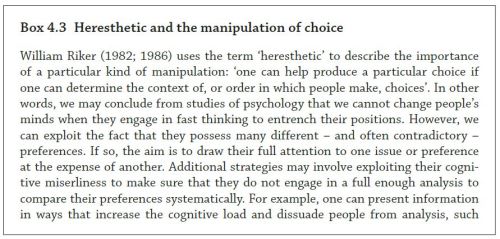Please see the Policy Analysis in 750 words series overview before reading the summary.
William H. Riker (1986) The Art of Political Manipulation (New Haven: Yale University Press)
Most texts in this series describe the politics of policy analysis, in which your aim is to communicate with a client to help them get what they want, subject to professional standards and ethics (Smith, Bardach, and Weimer and Vining).
Such texts suggest that the evidence will not speak for itself, and that your framing of information could make a big difference between success and failure. However, they tend to dance around the question of how to exercise power to maximise your success.
The consequence may be some bland Aristotle-style advice, in which you should seek to be a persuasive narrator by combining:
- Pathos. The appeal to an audience’s emotions to maximise interest in a problem.
- Logos. The concise presentation of information and logic to make a persuasive case.
- Ethos. The credibility of the presenter, based on their experience and expertise.
Studies of narrative suggest that these techniques have some impact. Narrators tap into their audience’s emotions and beliefs, make a problem seem ‘concrete’ and urgent, and romanticise a heroic figure or cause. However, their success depends heavily on the context, and stories tend to be most influential of the audiences predisposed to accept them.
If so, a key option is to exploit a tendency for people to possess many contradictory beliefs, which suggests that (a) they could support many different goals or policy solutions, and (b) their support may relate strongly to the context and rules that determine the order and manner in which they make choices.
In other words, you may not be able to ‘change their minds’, but you can encourage them to pay more attention to, and place more value on, one belief (or one way to understand a policy problem) at the expense of another. This strategy could make the difference between belief and action.
Riker (1986: ix) uses the term ‘heresthetic’ to describe ‘structuring the world so you can win’. People ‘win politically because they have set up the situation in such a way that other people will want to join them’. Examples include:
- Designing the order in which people make choices, because many policy preferences are ‘intransitive’: if A is preferred to B and B to C, A is not necessarily preferred to C.
- Exploiting the ways in which people deal with ‘bounded rationality’ (the limits to their ability to process information to make choices).
For example, what if people are ‘cognitive misers’, seeking to process information efficiently rather than comprehensively? What if they combine cognition and emotion to make choices efficiently? Riker highlights the potential value of some combination of the following strategies:
- Make your preferred problem framing or solution as easy to understand as possible.
- Make other problems/ solutions difficult to process, such as by presenting them in the abstract and providing excessive detail.
- Emphasize the high cognitive cost to the examination of all other options.
- Experiment with choice-rule options that consolidate the vote for your preferred option while splitting the vote of others.
- Design the comparison of a small number of options to make sure that yours is the most competitive.
- Design the framing of choice (for example, is a vote primarily about the substantial issue or confidence in its proponents?).
- Design the selection of criteria to evaluate options.
- Design a series of votes, in sequence, to allow you to trade votes with others.
- Conspire to make sure that the proponent of your preferred choice is seen as heroic (and the proponent of another choice as of flawed character and intellect).
- Ensure that people make or vote for choices quickly, to ward off the possibility of further analysis and risk of losing control of the design of choice.
- Make sure that you engage in these strategies without being detected or punished.
The point of this discussion is not to recommend that policy analysts become Machiavellian manipulators, fixing their eye on the prize, and doing anything to win.
Rather, it is to highlight the wider agenda setting context that you face when presenting evidence, values, and options.
It is a truism in policy studies that the evidence does not speak for itself. Instead, people engage in effective communication and persuasion to assign meaning to the evidence.
Similarly, it would be a mistake to expect success primarily from a well written and argued policy analysis document. Rather, much of its fate depends on who is exploiting the procedures and rules that influence how people make choices.
See also:
Evidence-based policymaking: political strategies for scientists living in the real world
Three habits of successful policy entrepreneurs
Evidence-informed policymaking: context is everything
Please note: some of this text comes from Box 4.3 in Understanding Public Policy 2nd ed










Pingback: Policy Analysis in 750 words: Michael Mintrom (2012) Contemporary Policy Analysis | Paul Cairney: Politics & Public Policy
Pingback: Policy Analysis in 750 words: Using Statistics and Explaining Risk (Sincerely) | Paul Cairney: Politics & Public Policy
Pingback: Policy Analysis in 750 words: Deborah Stone (2012) Policy Paradox | Paul Cairney: Politics & Public Policy
Pingback: Policy Analysis in 750 words: the old page | Paul Cairney: Politics & Public Policy
Pingback: Policy Analysis in 750 Words: Reflecting on your role as a policy analyst | Paul Cairney: Politics & Public Policy
Pingback: Policy Analysis in 750 Words: Defining policy problems and choosing solutions | Paul Cairney: Politics & Public Policy
Pingback: Policy Analysis in 750 Words: Separating facts from values | Paul Cairney: Politics & Public Policy
Pingback: Policy Concepts in 1000 Words: Contradictions in policy and policymaking | Paul Cairney: Politics & Public Policy